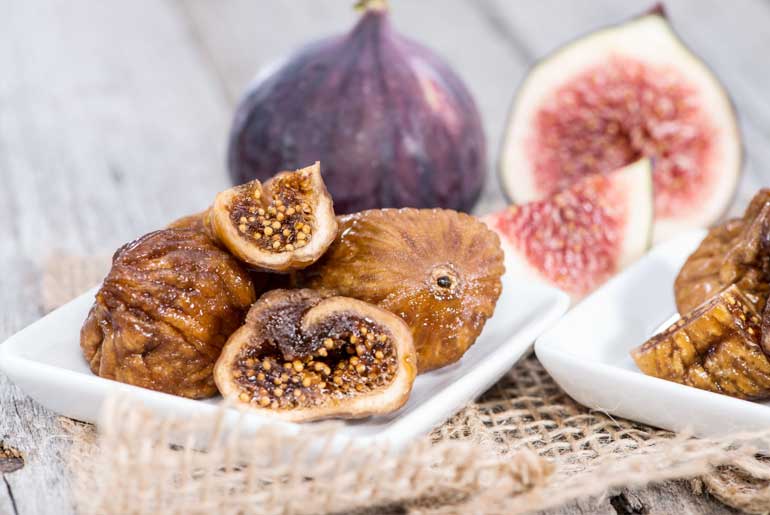Figs, considered one of the oldest fruits in the world, are renowned for their delightful sweet and creamy taste, which often provides the satisfaction of enjoying a dessert. These versatile fruits can be consumed both fresh and dried, and they have a long history of use as a natural sweetener in desserts, as well as for their potential health benefits.
The history of fig consumption dates back over 11,000 years ago to Jericho, a Palestinian city in the West Bank, where evidence of fig cultivation has been found. Figs were a dietary staple in ancient Rome and were frequently used as a natural sweetener. In ancient Egypt, figs were not only used for their sweetness but also as a preservative. They have been a significant part of Middle Eastern and Mediterranean cuisines for centuries.
Figs are a nutritional powerhouse, rich in essential nutrients such as magnesium, potassium, calcium, iron, and Vitamin K. These nutrients make figs an excellent choice for promoting heart health and overall well-being. The high fiber content in figs is particularly noteworthy, as it can help control cravings, keep you feeling full, and support weight loss efforts. Additionally, figs are a valuable source of antioxidants, which may have a role in preventing certain types of cancer.
So, beyond their delightful taste, figs offer a range of health benefits and have a fascinating historical significance as a dietary staple and natural sweetener throughout the ages.
Benefits of figs:
Indeed, figs are a nutritional powerhouse with a variety of health benefits. Their high dietary fiber content is a key feature that makes them an excellent choice for those aiming to manage their weight. The fiber in figs helps control appetite and contributes to a feeling of fullness, which can ultimately reduce overall calorie intake and support weight management.
Furthermore, figs are a valuable source of antioxidants. Antioxidants play a crucial role in protecting cells from damage caused by free radicals and oxidative stress. This protection may help prevent various health conditions, including cancer. So, by including figs in your diet, you not only enjoy their sweet and satisfying flavor but also support your overall health and well-being through their nutritional and antioxidant-rich properties.
1. Aids weight loss:
Figs, or anjeer, are indeed a fantastic option for individuals who are looking to manage their weight. Their high fiber content is a key factor that makes them a valuable addition to a weight loss plan. Here’s how figs can aid in weight loss:
- Feel Fuller for Longer: Figs are a rich source of dietary fiber, which can help you feel fuller for an extended period. This feeling of fullness can be especially helpful in reducing the frequency of snacking and promoting longer intervals between meals.
- Nutritious Snacking: Dried figs make for a nutritious and convenient snack. They are portable and can be easily included in your diet as a mid-morning or afternoon snack.
By incorporating 2 or 3 dried figs into your diet, you can experience the benefits of increased satiety and potentially reduce the overall calorie intake, which can support your weight management goals. However, it’s essential to maintain a balanced diet and a healthy lifestyle to achieve your weight loss objectives effectively.
2. Helps relieve constipation:
Figs have long been recognized for their potential to alleviate constipation, making them a valuable remedy for promoting healthy digestion. Their effectiveness in relieving constipation is attributed to their high content of soluble fiber. Soluble fiber adds bulk to the stool, softens it, and facilitates regular bowel movements. Here’s a simple method to harness the benefits of figs for constipation relief:
Method:
Consume 2 to 3 dried figs on an empty stomach.
This practice can help ease the process of passing stools and relieve constipation, contributing to improved intestinal health and overall well-being. It’s important to ensure that you’re well-hydrated when increasing fiber intake to maximize its effectiveness in alleviating constipation.
3. Can improve digestive wellness:
Figs have the potential to enhance digestive wellness through several mechanisms:
- Prebiotic Content: Figs are a valuable source of prebiotics. Prebiotics are non-digestible fibers that serve as food for beneficial gut bacteria, known as probiotics. By promoting the growth and activity of probiotics, prebiotics like those found in figs can contribute to improved digestion and overall gut health.
- High in Dietary Fiber: The high fiber content in figs, both soluble and insoluble, adds bulk to the stool. This facilitates regular and healthy bowel movements, preventing issues like constipation and promoting digestive regularity.
By incorporating figs into your diet, you can harness their prebiotic properties and fiber content to potentially enhance your digestive wellness.
4. Might control blood pressure:
Figs, due to their rich potassium content, can potentially contribute to controlling blood pressure. In an environment where fast-food consumption is on the rise, high blood pressure has become a prevalent health issue. Often, high blood pressure is associated with an imbalance in potassium levels in the body. Figs, being a natural source of potassium, have the potential to help restore this balance, which may aid in regulating blood pressure.
As a result, including figs in your diet could be a natural and nutritious approach to promote healthy blood pressure levels and counteract the effects of excessive sodium consumption commonly found in fast food. However, maintaining an overall balanced and health-conscious diet, along with reducing sodium intake, is essential for comprehensive blood pressure management. It is advisable to seek guidance from a healthcare professional for personalized recommendations in dealing with high blood pressure.
5. Figs for fertility:
Figs have a historical association with fertility, particularly in ancient Greek culture. This connection is partly due to figs being seen as a symbol of fertility. Recent research has supported this link, primarily because figs are rich in iron. Iron is crucial for female ovulation and can impact sperm quality and motility in males. Figs are often consumed with milk as a traditional practice to enhance reproductive health.
6. Could improve heart health:
Figs are beneficial for heart health due to their high fiber and potassium content, which can reduce excess fat and lower blood pressure, thus improving heart health. Figs’ antioxidants also combat free radicals, reducing triglycerides and bad cholesterol, ultimately promoting a stronger and longer-lasting heart.
How was fig used in ancient times:
Figs have a rich history of traditional medicinal use across different cultures. In ancient India, Ayurvedic texts recognized figs for their digestive and laxative properties. Greeks associated figs with fertility and strength, and the Egyptians used them to treat various ailments. These historical uses highlight the widespread appreciation for figs’ healing qualities.In ancient India, figs had a dual role:
1. Ancient India
- Culinary Use: Figs were a part of traditional Indian cuisine, where they were used to prepare sweet dishes, desserts, and snacks. They were also enjoyed fresh when they were in season, adding a natural sweetness and flavor to various culinary creations.
- Medicinal Use: In the context of Ayurveda, the ancient Indian system of medicine, figs were believed to possess medicinal properties. They were used to address a range of health issues, including digestive problems and respiratory ailments. Figs were often employed as a general tonic to promote well-being.
Figs have been appreciated for both their culinary and medicinal qualities in Indian culture, and they remain easily accessible and popular worldwide.
2. Ancient Greece and Rome:
Figs played significant roles in various ancient cultures:
- Ancient Greece and Rome: Figs were a dietary staple, consumed fresh and dried. Athletes appreciated their energy and nutritional value.
- Ancient Egypt: Figs were highly valued and used as a sweetener and preservative, with dried figs being a common food item and even used in the embalming process.
- Middle Eastern and Mediterranean Regions: Figs have been integral to the cuisines of these regions, used in both savory and sweet dishes, including desserts like baklava. They were also important in ancient trade routes and cultural exchanges.
- Ancient China: In traditional Chinese medicine, figs were used for their perceived health benefits, such as aiding digestion, promoting longevity, and boosting the immune system.
Figs’ versatility and cultural significance made them not only a source of sustenance but also a symbol of tradition, trade, and health across various ancient civilizations.
How to add fig to the diet:
These are some creative and delicious ways to incorporate figs (anjeer) into your meals:
1. Fruits and Fig Salad:
Ingredients: Figs, pineapple, strawberries, guavas, raisins, pumpkin seeds.
Instructions: Chop the figs and other fruits into bite-sized pieces, then toss them together. Sprinkle some raisins and pumpkin seeds on top for added texture and nutrition. You can also drizzle a bit of honey or a yogurt dressing if you prefer.
2. Oats and Fig Breakfast:
Ingredients: Figs, oats, milk, grapes (or other preferred fruits).
Instructions: Add chopped figs to a bowl of oats and milk. Top it with grapes or any other fruits you like. This makes for a hearty and healthy breakfast option.
3. Anjeer Yoghurt Dessert:
Ingredients: Figs, yogurt, honey.
Instructions: Cube the figs and add them to a bowl of yogurt. Drizzle honey over it for a sweet touch. This makes for a simple and tasty dessert or snack.
4. Fig Chutney:
Ingredients: Figs, jaggery, chilies.
Instructions: Blend figs, jaggery, and chilies together to create a chutney with a sweet and spicy kick. Chill it for 30 minutes and store it in a container. This chutney pairs well with roti, bread, or as a condiment for various dishes.
5. Fig Milkshake:
Ingredients: Figs, milk, honey, pumpkin seeds.
Instructions: Blend figs with milk to make a creamy milkshake. Add honey for sweetness and a handful of pumpkin seeds for added nutrition. This makes for a refreshing and nutritious drink.
These recipes offer a variety of ways to enjoy the unique flavor and health benefits of figs in your meals and snacks. Be creative and feel free to adjust the ingredients and quantities to suit your taste and dietary preferences.
Who shouldn’t have fig:
Figs may not be suitable for individuals with latex allergies due to the potential for cross-reactivity. People with diabetes should also consume figs in moderation because of their naturally high sugar content.
Interesting facts about fig:
- Ancient Fruit: Figs are indeed one of the oldest known fruits in the world, with a history dating back thousands of years.
- “Poor Man’s Food”: Figs were historically referred to as the “poor man’s food” due to their availability and affordability in many regions.
- Nutrient-Rich Dried Figs: Dried figs are high in fiber, iron, and various minerals, making them a nutritious and convenient snack.
- Tall Fig Trees: Fig trees can grow to impressive heights, with some reaching over 100 feet tall under optimal conditions.
- Biblical Mention: Figs are mentioned frequently in the Bible and hold cultural and symbolic significance in various traditions.
- Laxative Qualities: Figs have mild laxative properties, which can aid in digestion and provide relief from constipation.
- Meat Tenderizer: Figs contain protein-digesting enzymes that can break down muscle and connective tissue in meat, making them a natural meat tenderizer and flavor enhancer.
- Cutting Dried Figs: When chopping dried figs by hand with a knife or scissors, dipping the cutting implement into warm water occasionally can help prevent sticking and make the process easier.
- Restoring Moisture: If dried figs seem hard or too dry, they can be soaked, steamed, or poached to restore moisture and make them more pliable for various culinary uses.
- Versatile Ingredient: Dried figs can be used interchangeably with prunes, dried apricots, and dates in many recipes, adding natural sweetness and flavor to dishes.
These facts highlight the rich history, versatility, and nutritional value of figs, making them a fascinating and useful fruit.
Disclaimer:
The information contained in this article is for educational and informational purposes only and is not intended as a health advice. We would ask you to consult a qualified professional or medical expert to gain additional knowledge before you choose to consume any product or perform any exercise.









